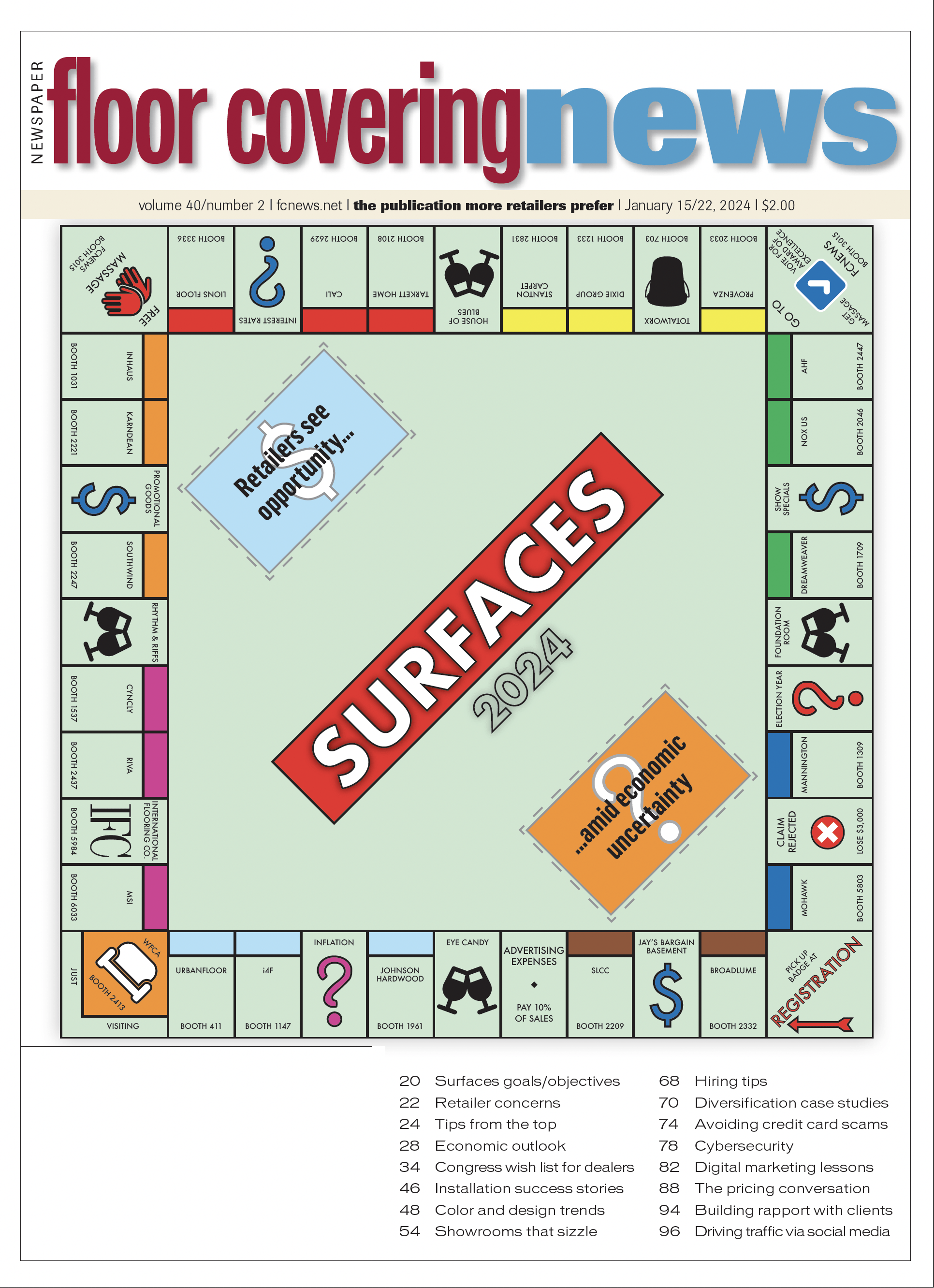 Businesses and consumers should expect to see high interest rates heading into 2024, although the rate of increase and severity of the increases should be lower during the year. At the same time, we can anticipate tough conditions on the new home construction side of the market, while those involved in commercial work should be able to ride things out on the strength of work already in the pipeline.
Businesses and consumers should expect to see high interest rates heading into 2024, although the rate of increase and severity of the increases should be lower during the year. At the same time, we can anticipate tough conditions on the new home construction side of the market, while those involved in commercial work should be able to ride things out on the strength of work already in the pipeline.
That was the main thrust of a pair of informative economic keynote presentations delivered by ITR Economics last fall during the North American Association of Floor Covering Distributors+ North American Building Materials Distribution Association (NAFCD+NBMDA) conference.
In one presentation titled “Piercing Through the Noise,” Brian Beaulieu—a familiar face at past NAFCD conferences—painted a cautiously optimistic outlook on the housing market. In the keynote session that preceded Beaulieu’s talk, “Economic Trends in Construction and Consumer Markets,” Connor Lokar, senior economist with ITR Economics, expressed similar concerns about the impact of a weak housing market—especially low housing starts—on the floor covering industry.
Outlook on U.S. housing market
 “The housing market will begin to stabilize as we go through 2024 and begin to show more appreciable signs of recovery in 2025,” Beaulieu said. “If you’re on the non-residential side of the street, you’re going to be doing very well in 2024 but it’s in 2025 where you’re going to be feeling some pain.”
“The housing market will begin to stabilize as we go through 2024 and begin to show more appreciable signs of recovery in 2025,” Beaulieu said. “If you’re on the non-residential side of the street, you’re going to be doing very well in 2024 but it’s in 2025 where you’re going to be feeling some pain.”
Single-family housing starts, defined by ITR Economics as a “leading indicator,” will continue to be hamstrung by high mortgage interest rates (a by-product of stubbornly high inflation), low inventories and low housing starts. But the silver lining in all this, according to ITR, is we may have already seen the bottom.
“The housing market is actually starting to recover,” Lokar stated. “When I spoke at this conference [in 2022], the market was in freefall, trending negative and getting worse by the week. As of the third quarter 2023, we started to see single-family housing starts beginning to turn the corner.”
However, the term “recovery,” by ITR Economics’ standards, means conditions are becoming worse less quickly. “We’re not posting monstrous increases year over year, but we’re seeing some favorable conditions compared to this time last year,” Lokar noted.
Lokar also cited issues of concern on the multi-family side of the business. He shared statistics showing starts in this particular sector of the market were down 28.1 percentage points in the final stretch of 2023. At the same time, he said the existing new home construction market has stalled as builders continue to face pricing pressures.
“We need the housing market to come back to life—to be more dynamic,” Lokar stated. “But that all depends on interest rates. The rate threat remains a concern.”
Inflation threat
 While the Federal Reserve has held rates steady during its past few meetings, that doesn’t necessarily mean we’re going to see a dramatic turnaround to kick off 2024. “We expect marginal reductions in mortgage interest rates in 2024, but not the 2.5% rates we had back in 2019- 2020,” Lokar said. “You’re probably looking at more like 6%.”
While the Federal Reserve has held rates steady during its past few meetings, that doesn’t necessarily mean we’re going to see a dramatic turnaround to kick off 2024. “We expect marginal reductions in mortgage interest rates in 2024, but not the 2.5% rates we had back in 2019- 2020,” Lokar said. “You’re probably looking at more like 6%.”
While high inflation is clearly the main issue on the minds of consumers and business owners alike, Beaulieu said the rates we’re seeing today are by no means unprecedented. “We’ve seen worse inflation than this; we lived through worse than this in the ‘70s and the ‘80s. Yes, we wore awful suits. We had those wide lapels and pastel colors, but at least we survived. And for the millennials who are worried about high interest rates today, asking how they are ever going to get into a home, you should know this: I bought my first home in the early 1980s. You find a way when you want something bad enough.”
Credit availability
 With delinquency rates on the rise, and with banks and financial institutions tightening their belts, loans will be harder to come by for some. “Credit conditions will continue into 2024,” Beaulieu said. “Banks are going to come under even more stress and be even less willing to lend money, because of what’s coming at us in terms of the commercial real estate market. So much of that debt is held by regional and small banks. However, if you’re an individual looking for credit and you have a credit score of 720 or better, you’re going to sail through the banking system. If you’re a business looking for some credit, given these numbers, you better have a very strong balance sheet and a compelling story. It also helps to have a good relationship with your bank.”
With delinquency rates on the rise, and with banks and financial institutions tightening their belts, loans will be harder to come by for some. “Credit conditions will continue into 2024,” Beaulieu said. “Banks are going to come under even more stress and be even less willing to lend money, because of what’s coming at us in terms of the commercial real estate market. So much of that debt is held by regional and small banks. However, if you’re an individual looking for credit and you have a credit score of 720 or better, you’re going to sail through the banking system. If you’re a business looking for some credit, given these numbers, you better have a very strong balance sheet and a compelling story. It also helps to have a good relationship with your bank.”
This phenomenon will have larger implications on the commercial real estate end of the business. “Banks are going to be less and less inclined to lend money until they can clear dead assets off of their books,” Beaulieu said. “The mountain of debt that needs to be cleared from office buildings in particular, especially over the next three years, is mind-numbing. Lowering interest rates will help. Yes, I think 2024 and 2025 will be tough, but in 2026 you’ll find that lending standards will begin to ease again.”
Impact of Israel-Hamas conflict on the U.S. economy
“People are asking us what effect the conflict in the Middle East might mean for the U.S. economy,” Beaulieu said. “At this time it means nothing for the U.S. economy. It is not going to impact your markets, it’s not going to impact your lives other than emotionally. The only thing that could change that view is if the war broadens and we find that it involves oil supplies and oil prices go scooting upward significantly—that would have a detrimental impact on our economy as well as other countries.”
Election-year politics
 “The elections are one of my least favorite times,” Beaulieu said. “[Candidates] just say whatever they want to say and it doesn’t matter whether it’s true or not. I call it the ‘silly season.’”
“The elections are one of my least favorite times,” Beaulieu said. “[Candidates] just say whatever they want to say and it doesn’t matter whether it’s true or not. I call it the ‘silly season.’”
ITR Economics cited a chart showing GDP growth during past administrations—beginning with Eisenhower up to present day—in a move to demonstrate that a particular president or political party has little bearing on the performance of the U.S. economy. “Doesn’t matter whether it’s red or blue,” Beaulieu said. “And that’s because the U.S. economy is larger than it used to be. Part of that is because the government has continued to grow, along with our national debt, and that has begun to suck the life out of our ability to grow larger. It is noteworthy that whether you’re talking about Bush, Obama, Trump or, presently, Biden, we’re all in the same neighborhood in terms of growth. So don’t for a second think a change in administration is what’s going to power the economy in 2025, when we forecast a turnaround. That isn’t what’s going to power us up; there are other factors that you need to look at other than who won the election.
“We’re going to focus on the economy so you can gauge for yourself if what you’re hearing from any politician makes any sense at all when it comes to domestic economic policy. The real concern we have is corporate profits are running below year-ago levels, and they’re down from their record high of September 2022. When corporate profitability starts to weaken, you find that capital expenditure decisions and acquisition decisions are put on hold. In addition, expansions of many kinds of technology purchases are put on hold—and that’s going to contribute to the slowdown in 2024.
“Everyone will need to do a better job of assessing their cash flow through 2024, maybe even into 2025. Cash is king at the bottom of a recession, so cash is
going to be king in late ‘24 and early ‘25. Make sure you have as much of it on hand as possible to execute on some growth plans.”
GDP forecast
The uptick in U.S. gross domestic product (GDP) seen in the third quarter of 2023 was driven by non-farm inventories, according to ITR Economics. However, a trend shift from discretionary spending to “mandatory” spending will temper GDP activity in 2024. “We saw GDP growth slow down in the fourth quarter of 2023, and we’re expecting to see that decline gradually continue in 2024,” Beaulieu stated. “But we expect manufacturing, and by extension GDP, will rise in 2025 and continue through 2029.”
Labor pool
 “Finding people has been increasingly difficult,” Beaulieu said. “You can automate some of that problem away, but you are also paying your people more and more. Job openings are coming down, but so is the quit rate.”
“Finding people has been increasingly difficult,” Beaulieu said. “You can automate some of that problem away, but you are also paying your people more and more. Job openings are coming down, but so is the quit rate.”
Looking at the labor participation rates across the different age groups, ITR noticed an anomaly: a big drop in the 16-to-24-year-old participation rate.
“This correlation doesn’t necessarily mean causation, but I think it’s logical,” Beaulieu said. “That huge precipitous drop ties in with the availability of student loans in college, so they didn’t have to work. They got loans to go to college. They weren’t working in the pubs, they weren’t working in the restaurants, they weren’t working summer jobs—they just have loans instead. Now we’re seeing that even for the young people, who currently don’t like to work much anymore, are back to working at levels that we haven’t seen since before the COVID-19 pandemic.”
For those in the flooring/construction industry who are looking to fill their future labor ranks, Beaulieu suggested a grassroots approach. “If I were you, what I would be doing is going into the high schools—talking to freshmen, sophomores, juniors, seniors—about the wages that they could be earning and they don’t have to incur all this debt. They’ll get into a house, they’ll drive a better car, they’ll have a family that much sooner. Put some icing on the cake and tell them you’ll pay for their trade school tuition if they’ll sign a contract to work for you for three or four years after they graduate from the trade school. Try to discourage them from becoming world history majors or philosophy majors. Tell them you’re doing them a big favor.”
Betting big on America
With all the talk of political divisions and economic challenges facing America, ITR is still betting big on the U.S. “Every analyst has a bias, whether that’s your shrink or any other type of analyst,” Beaulieu quipped. “I’m going to tell you my bias: My bias is I believe in America, I believe in capitalism. I believe [the executives in this industry] know more about business than any parliament and any congress, including our own. Do what’s right to grow your business and take care of your people. America takes care of our people, and as a result the economy is getting better. China is in decline; we’re seeing more direct foreign investment in the United States.”
Instead of fretting about the larger, global macro issues, ITR advises business leaders to focus on those things within their power to control. “You’re either going to be focusing on the downturn, which looks mild in 2024, or you’re going to ask yourself the most significant strategic questions: ‘Am I ready? Do I have the cash? Do I have the people? Do I have the material? I need to see growth happen for my business in 2025, ‘26, ‘27, ‘28 and ‘29.’ You and I can’t control this macro stuff. All we can control is how we respond to it and how we prepare for it.
“Yes, labor is going to remain tight and expensive. What are you going to do about that? Do you have a plan for dealing with that? Inflation is coming down right now, but it’s going to be soaring back up by the end of this decade. How are you going to contend with that? You and I can’t change any of those trends, but what we can manage is how we’re going to lead through those variables. That’s your job to lead through and to pass general macroeconomic trends.”

